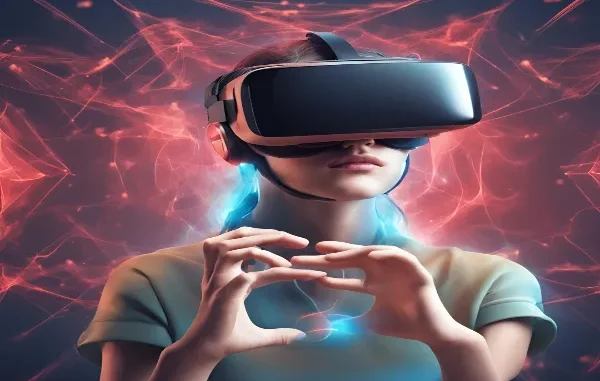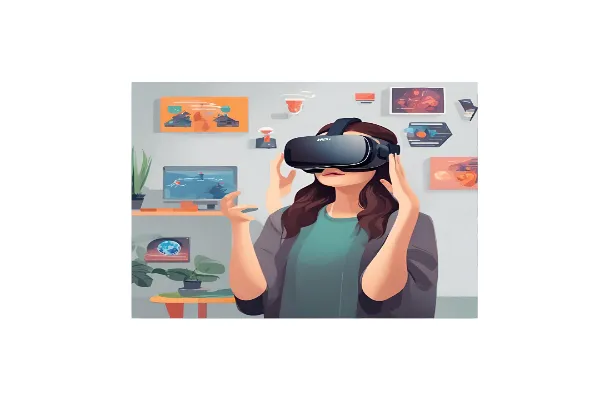
Virtual Reality (VR) isn’t science fiction anymore. It’s a technology that crafts a simulated, three-dimensional world around you. Imagine yourself scaling the peak of Mount Everest, feeling the crisp mountain air and witnessing breathtaking panoramic views. Or picture yourself exploring the depths of the ocean, swimming alongside exotic marine life. Virtual Reality (VR) makes these experiences, and countless others, possible from the comfort of your living room. But how does VR weave this immersive illusion? Let’s enter into this interesting world.
What is Virtual Reality?
Imagine yourself transported to a new reality –– trekking through a rainforest canopy, exploring the surface of Mars, or even attending a concert with friends from across the globe. VR utilizes headsets equipped with high-resolution displays and motion sensors to track your movements. This creates an immersive experience where you feel present within the virtual world, and your actions directly influence what you see and interact with.
When was Virtual Reality Invented?
The concept of virtual reality has captivated minds for decades, appearing in science fiction works long before it became a technological reality. While the term “virtual reality” was coined in the late 1980s, the first forays into VR hardware emerged much earlier. In 1968, the “Sword of Damocles,” a cumbersome head-mounted display, offered a glimpse into a virtual environment. The 1990s saw advancements like the Nintendo Virtual Boy, but widespread consumer adoption remained elusive. Today’s VR technology continues to evolve rapidly, offering increasingly immersive and user-friendly experiences.
From Fully Immersive to Non-Immersive VR
The world of VR offers a spectrum of experiences, each catering to different needs and applications. Here’s a breakdown of the key types:
- Fully Immersive VR: This is the holy grail of VR immersion. Users are completely transported into a digital world, with no visual or sensory connection to their physical surroundings. Think exploring a virtual museum or battling aliens in a VR game – fully immersive VR creates a captivating reality all its own. Specialized headsets, gloves, treadmills, and sensory detectors often play a role in crafting this hyper-realistic experience.
- Semi-Immersive VR: Here, the line between reality and the virtual world blurs. Digital elements seamlessly overlay real objects, allowing users to interact with them in a blended environment. This makes semi-immersive VR ideal for training purposes, such as pilot simulations or practicing technical skills. Imagine a mechanic trainee manipulating virtual components superimposed on a real engine – that’s the power of semi-immersive VR.
- Non-Immersive VR: This type offers a more basic VR experience. Users interact with a digital environment primarily through a computer screen or projection system. While lacking the full immersion of other VR types, non-immersive VR is still valuable for applications like classic video games or driving simulators. These experiences introduce users to the basic principles of VR without requiring specialized equipment.
Augmented and Mixed Reality VR
While often grouped under the VR umbrella, Augmented Reality (AR) and Mixed Reality (MR) offer distinct experiences. AR overlays digital elements onto the real world, accessed typically through smart glasses or mobile devices. Imagine a furniture store using AR to allow customers to virtually place furniture in their homes – that’s the power of AR.
MR, on the other hand, seamlessly blends the physical and virtual worlds. It’s a more advanced form of AR, often used in marketing to visualize products or people in a real-world context. Imagine a car company using MR to allow customers to virtually test drive a new car model in their driveway – that’s the innovative potential of MR.
A Breakdown of the Essential Components of Virtual Reality
Virtual reality wouldn’t be possible without a harmonious interplay of various components. Here’s a closer look at the key elements that bring VR experiences to life:
- The Gateway to the Virtual World: The Headset
The VR headset acts as your portal to the digital realm. It replaces your natural field of view with a computer-generated one, transporting you to fantastical landscapes or immersive simulations. Inside the headset, intricate components like infrared LEDs, motion sensors, cameras, and high-resolution screens work in concert. These components gather real-time information about your head movements and translate them into the virtual world, creating a seamless sense of presence.
- The Art of Illusion: Screens and Lenses
The magic of VR visuals lies within the headset’s screens and lenses. These components work together to create a realistic sense of depth and dimension. By subtly distorting and overlapping two slightly different images, one for each eye, the VR system creates a stereoscopic effect that mimics natural human vision. This allows your brain to perceive a convincing sense of three-dimensionality within the virtual environment.
- The Importance of Speed: Latency and Frame Rate
For a truly immersive experience, responsiveness is paramount. Latency, the time it takes for your actions to be reflected in the VR world, needs to be minimal. Imagine turning your head in VR –– ideally, the virtual environment adjusts instantly, maintaining a seamless connection between your movements and the digital world.
Similarly, the frame rate, the number of images displayed per second, plays a crucial role. A higher frame rate translates to smoother visuals, mimicking the natural way our eyes perceive the world. VR headsets typically aim for a frame rate of at least 90 FPS (frames per second) to ensure a comfortable and realistic experience.
- Moving in the Virtual World: Position Tracking
Imagine being stuck in a virtual world, unable to move freely. Thankfully, VR incorporates position tracking technology. This system, often using 6 degrees of freedom (6DoF), tracks your movements in space. Whether you tilt your head, take a step forward, or even crouch down, the VR environment adjusts accordingly. This allows for a natural and intuitive way to navigate and interact with the virtual world, further enhancing the immersive experience.
The Foundation: Hardware and Software
VR relies on a powerful ecosystem of hardware and software working in perfect harmony. The centerpiece is the VR headset, a helmet-like device equipped with two high-resolution displays, one for each eye. These displays project slightly different images, mimicking the natural way our eyes perceive depth in the real world.
The Power Behind the Image: Rendering
To create the virtual environment, powerful software is needed. This software, known as a VR engine, acts as the architect, meticulously crafting the digital world in three dimensions. It renders intricate details like landscapes, objects, and characters, ensuring a smooth and realistic experience.
Tracking Your Every Move: Motion Sensors
Imagine exploring a virtual forest without the ability to move around. Thankfully, VR incorporates motion sensors strategically placed on the headset and controllers. These sensors track your head movements and physical actions in real-time. As you tilt your head, the virtual world adjusts accordingly, creating a seamless sense of presence.
Breaking the Physical Barrier: Controllers and Haptics

VR controllers act as your virtual hands, allowing you to interact with the environment. They are equipped with buttons and triggers that translate your physical movements into actions within the VR world. Imagine grabbing a virtual object or wielding a sword in a VR game – controllers make it possible.
Haptic technology adds another layer of realism. Haptic feedback simulates the sense of touch, allowing you to feel vibrations, bumps, and textures within the virtual world. Imagine feeling the recoil of a virtual gun or the rough surface of a virtual rock – haptics bring these sensations to life.
The Symphony of VR: Bringing it All Together
Now, let’s orchestrate this intricate system. The VR engine renders the virtual environment and sends these images to the headset’s displays. Simultaneously, motion sensors track your movements, and controllers translate your actions. All this information is processed at lightning speed, ensuring the virtual world updates seamlessly in sync with your head movements and physical actions. This real-time responsiveness is crucial for creating a believable and immersive VR experience.
Beyond the Headset: Expanding the VR Universe
While the VR headset is the core device, other peripherals can further enhance the experience. Omnidirectional treadmills allow you to walk or run in place within the virtual world, adding a layer of physical exertion. Specialized VR gloves can translate even finer hand movements into the virtual environment, enabling more nuanced interactions.
The Future of VR: Pushing the Boundaries
The future of VR technology gleams with exciting possibilities. We can expect advancements in resolution and refresh rates, blurring the lines between reality and the virtual world. Integration of other senses like smell and taste is being explored, promising even more immersive experiences.
VR applications are poised to expand beyond entertainment, revolutionizing fields like education, healthcare, and workplace training. Imagine attending virtual classrooms on the Great Barrier Reef or undergoing surgery simulations in a risk-free VR environment. The possibilities are boundless, and VR technology is steadily evolving to make them a reality.
Virtual Reality Pros and Cons
Virtual Reality offers a treasure trove of potential, but it’s not without its limitations. On the plus side, VR shines in education and training, allowing for immersive simulations and experiences that traditional methods can’t replicate. It also unlocks new avenues for entertainment, transporting users to fantastical worlds or creating hyper-realistic gaming experiences. However, VR can be expensive, with high-quality headsets requiring a significant investment.
Additionally, concerns exist about potential health risks associated with prolonged use, such as eye strain and motion sickness. The social aspect is another consideration, as VR experiences can be isolating, potentially hindering real-world interactions. Ultimately, VR is a powerful tool, but it’s important to weigh the pros and cons before diving into this immersive world.
Ready to Dive into Virtual Reality?
The world of virtual reality offers endless possibilities to explore, learn, and experience the impossible. With its innovative technology and ever-expanding capabilities, VR is poised to revolutionize how we interact with the digital world. So, are you ready to take the plunge and experience the magic of VR for yourself?

Leave a Reply